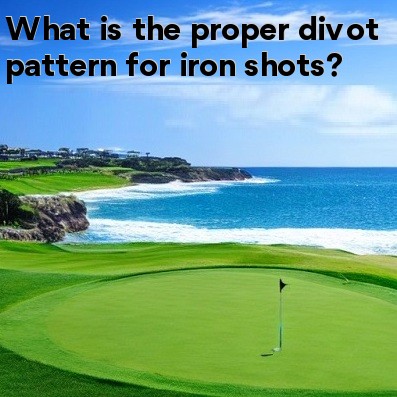
The Proper Divot Pattern for Iron Shots in Golf
When it comes to iron shots in golf, creating the right divot pattern is essential for consistent and accurate ball striking. Divots provide valuable feedback about the quality of a swing and can offer insights into areas that need improvement. In this article, we will explore the proper divot pattern for iron shots and how to achieve it.
Divot Pattern
The ideal divot pattern for iron shots is a shallow and linear divot that starts after the ball and continues towards the target. This type of divot indicates that the golfer is striking the ball first and taking a divot afterwards, which promotes a crisp contact and optimal ball flight.
It's important to note that divots should be approximately the size of a dollar bill, with a consistent depth of around an inch. This signifies a clean sweep through the turf and ensures the proper interaction between the clubface and the ball.
Proper Technique
To achieve the desired divot pattern, it is crucial to focus on the following aspects of your iron swing:
- Ball Position: Place the golf ball slightly ahead of center in your stance. This helps ensure that you reach the bottom of your swing arc after striking the ball, creating the ideal divot pattern.
- <strong<Angle of Attack: Develop a descending angle of attack into the ball, which means striking down on the ball. This promotes a ball-first contact and encourages the creation of a shallow divot.
- Divot Direction: The divot should start just after the ball and continue towards the target. This indicates that your swing path is on the right track and helps maintain control over the ball flight.
- Body Alignment: Ensure that your body and clubface are aligned properly. Proper alignment plays a significant role in achieving the desired divot pattern.
- Weight Transfer: Transfer your weight appropriately during your swing, shifting it from your back foot to your front foot. This helps promote a downward strike and encourages a proper divot.
Common Mistakes
It's important to identify and avoid common mistakes that can lead to improper divot patterns. Some of these mistakes include:
- Hitting Behind the Ball: Striking the ground too far behind the ball can result in deep divots and poor ball contact.
- Creating Too Steep a Divot: Taking divots that are too steep can indicate a swing that is too steep or “scooping” through impact, leading to inconsistent shots.
- Divot Direction Away from Target: Divots that start before the ball or move away from the target can indicate an out-to-in swing path or an open clubface at impact.
By being aware of these mistakes and monitoring your divot pattern, you can make adjustments to your swing and improve your ball striking.
Practice and Persistence
Creating the proper divot pattern for iron shots requires practice and persistence. It is important to spend time on the range, focusing on the elements outlined above. Video analysis and feedback from a golf instructor can also be immensely valuable in identifying areas that need improvement.
Remember, every golfer's swing is unique, and it may take time to find the right adjustments for your game. Patience and consistent practice will lead to better ball striking and the development of a desirable divot pattern.
In conclusion, achieving the proper divot pattern for iron shots in golf is crucial for consistent and accurate ball striking. By applying the right technique, avoiding common mistakes, and dedicating time to practice, you will be on your way to improving your divot pattern and becoming a more skilled golfer.





